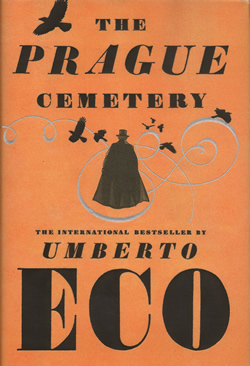Umberto Eco
Review by Dan Geddes
Umberto Eco’s The Prague Cemetery is an entertaining tour de force of 19th century European history. Blending history and fiction as in his previous novels (The Name of the Rose, Foucault’s Pendulum), Eco uses the fictional character, Captain Simone Simonini, a notary and a master document forger, as a unifying thread on which to hang major historical events. With the character of Simonini, Eco plays with the idea of forgery and its importance for history and literature.
As an adept creator of forged documents, Simonini shadows the paymaster of Garibaldi’s Thousand during the Italian Risorgimento, witnesses the revolutions of 1848, serves as a paid informer during the Franco-Prussian war and subsequent horrors of the Paris Commune, and even plays a key role in the Dreyfus Affair, among many other events. Simonini has the survival skills of a Talleyrand, practicing his black arts under various governments, such as the Kingdom of Piedmont, the Second Empire or the Third Republic in France.
Simonini is adept not only at forgery, but also at lying, double-crossing, impersonating and even murdering others in order to achieve his ends. His goal is to accumulate enough capital to live off the interest on ultra-safe government bonds. But even after he achieves this, he finds he misses “being a protagonist” and wants back into the action.
His career as a forger begins when, as a young man, he realizes that his grandfather’s notary has swindled him out of his inheritance by forging promissory notes; creditors claim all of his grandfather’s estate. After dispossessing Simonini, the notary offers to take him in as an apprentice, and Simonini learns both the trade of being a notary and an adept forger, eventually replacing the crooked notary and being recruited by Piedmont’s secret service.
Simonini highlights the central role of forgeries in history. The overarching thread is Simonini’s role as the author of the infamous Protocols of the Elders of Zion. This world famous anti-Semitic tract–purportedly a description of a secret meetings of Jewish elders and their plot to take over the world–is here shown as having undergone a long evolution. Simonini is described as having read Dumas’ (père) The Queen’s Necklace, Eugene Sue’s Les Mystères du Peuple as well as other works that described similar conspiracies, not only of the Jews, but also of Freemasons and Jesuits.
In an appendix called “Useless Learned Explanations” Eco explains that nearly all of the characters in this work are historical, except for Simonini himself.
Much of the enjoyment from this work comes from the rich details of 19th century European life: the description of locales, furniture and especially the food. Simonini is a gourmand with a passion for good food, but no passion for women. He finds women revolting.
The most implausible part of the story is that a character like Simonini, involved in so many black deeds, dealing with the spies of various nations, could survive. He simply knows too much. The French secret service appears especially gullible in its dealings with Simonini. Others, such as Gaviolini, fall too easily for Simonini’s schemes.
But clearly such a blend of history and fiction requires suspension of disbelief, and at a certain point the enjoyment of the novel becomes more the anticipation of how Eco will work Simonini into historical events (especially his central role in the Dreyfus Affair), rather than any realistic suspense about what will happen next. Simonini is an evil protagonist, perhaps guilty of all seven deadly sins, so we are not concerned that some unjust fate will befall him. Instead, we just marvel at Eco’s erudite blending of fact and fiction.
The Prague Cemetery is a fascinating text. Most of the chapters are standalone dramatic episodes with a beginning, middle and ending. Readers are denied the final dénouement of the Dreyfus affair (Dreyfus’ exoneration), but the scope and depth of Eco’s latest novel is impressive.
April 2012

